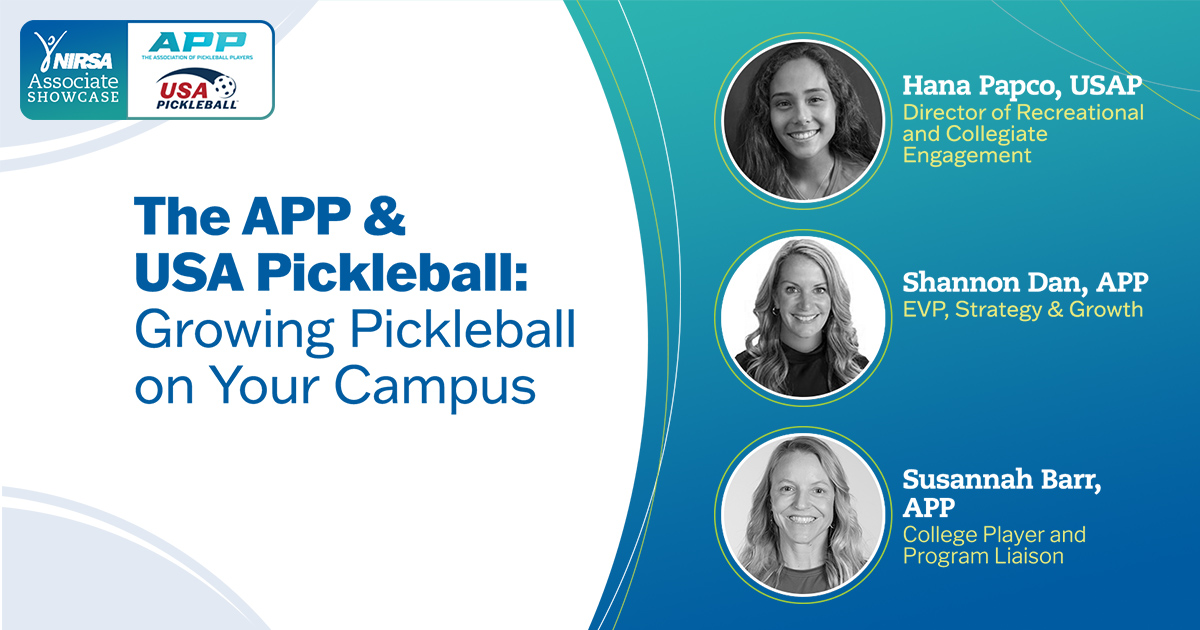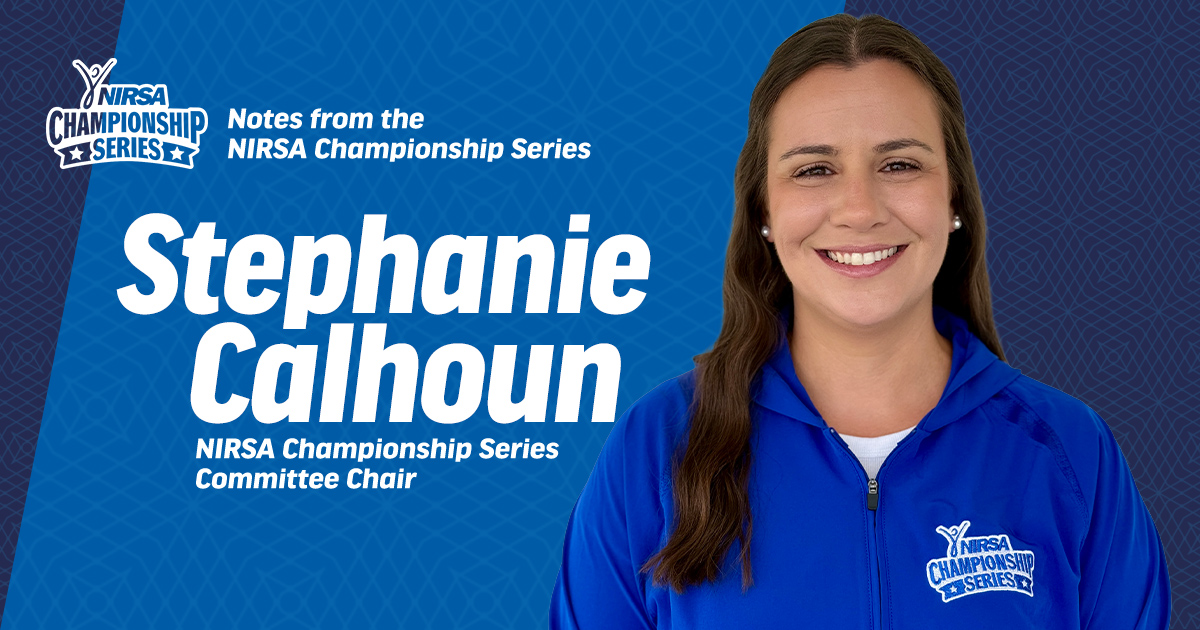By Erin O’Sullivan
The NIRSA Championship Series is more than just competition—and those words are more than just a tag line.
The multitude of people—the majority of whom are volunteering hours after long works days—striving to make the regional and national tournaments come to be, year after year, do so because of a shared understanding they have with the athletes they serve.
For these athletes, sport and competition are a way of life, a way of developing the best parts of themselves. University of Miami—Florida, junior midfielder, Paola Barrios, understands this well. “I played [soccer] ever since I was very little; it’s been a big part of my life. I couldn’t just stop playing when I went to college,” she says.
And, for the past twenty years, the NIRSA National Soccer Championship tournament has ensured that Paola, and the thousands of student-athletes like her, haven’t had to. In 1994, NIRSA institutional members and club coaches wanted something different for their players than what was currently offered—tournaments run by those outside of the collegiate arena, not including a women’s competition, and boasting a party atmosphere. They wanted something more inclusive and more focused on high-level soccer for their players, while at the same time offering a real platform for tournament staff and officials to develop professionally.
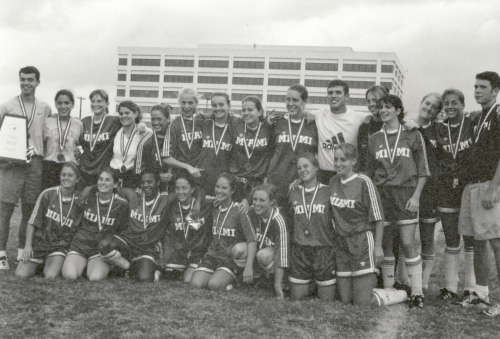 1996 Women’s National Champions, Miami University.
1996 Women’s National Champions, Miami University.The development of a tournament extends far beyond what participants get to see, or could even imagine. But the volunteers’ love for the game, and the students who play, makes it all worth it.
The first tournament, with 15 teams and just over 250 players, was night and day compared to today’s tournaments, which fills within minutes and features 96 teams with over 2000 players. However, this was just a dream back in 1994 when Howard Taylor, Director of Competition from 1994-2004, loaded up his van with two staff members and a trunk filled with corner flags to drive from his home campus in Wichita to the site of the first tournament in Austin.
The tournament’s regional structure has been a key to keeping its national championship tournament strong. The idea of having regional coordinators who rank the teams in their region for the championship division and then offering an open division as well was “really Howard’s brainchild,” Randall Ford, regional coordinator from 1995-2004 and Director of Competition from 2005-2013, explains. Moreover, the tournament’s two sides—the competitive ranking side and the open side—really “fit NIRSA’s mission for inclusive and encouraged participation and allows the tournament to also have the best of both worlds.”
 The University of Illinois’ Men’s team celebrates their win.
The University of Illinois’ Men’s team celebrates their win.Sometimes, achieving that balance has felt easier than at others. “In the third, fourth, fifth year of the tournament we started attracting the best teams; we reached that center of gravity that tipped in our direction,” Howard recalls. These were memorable years for many involved—the early struggles were over, but the tournament hadn’t yet grown to capacity. With between 40 and 60 teams involved, it was easy to get everyone together and get to know everyone involved, really invoking NIRSA’s familial atmosphere.
Now, especially with 96 teams, “it’s more like controlled chaos,” Doug Ewing, regional coordinator in 1997 and Director of Competition from 2005-present, says. But one thing that hasn’t changed is the pure love of competitive soccer—one of the values this tournament was founded on. You don’t have to be a varsity player to be an athlete; indeed, many of the clubs were coming from schools that did not have a varsity-level soccer team, and, therefore, this tournament was the pinnacle of their collegiate soccer careers. Doug and Howard both agree that the level of play here is “comparable to intercollegiate teams.”
Indicative of this, Howard says, is that officials—the right officials—were increasingly interested. “People heard this event was being run right; they heard men’s and women’s teams were being treated equally. And they wanted to be a part of that,” he says.
George Gately, an official for the NIRSA Soccer Championships since 1995, is one such person. “It is, easily, the best soccer event of my year, every year,” he says. “It’s not only the quality of play, the camaraderie of my fellow officials, but also the superior hospitality and exceptional thoughtfulness of NIRSA staff.”
Noah Yannie, Director of Officials from 1995-present, says he recruits—and keeps—these top officials by “relaying how the teams pay their own way; they’re here for all the right reasons, and they love soccer like you [officials] do.”
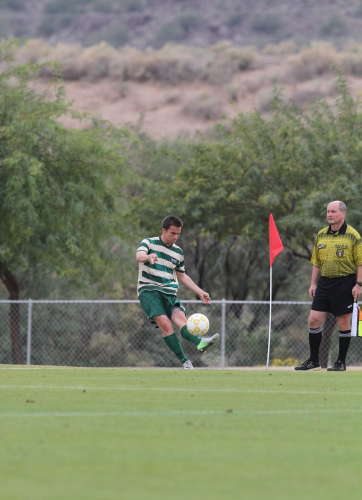 NIRSA’s officials are a key part of every tournament; 2013 was no exception.
NIRSA’s officials are a key part of every tournament; 2013 was no exception.The 60 officials from over 20 states are a crucial part of the tournament’s continued success. “A lot of officials could go elsewhere to do tournaments that would count for points towards their license—NIRSA doesn’t do that—but the officials enjoy it and want to come,” Doug says. “We couldn’t be who we are without them and the high level of play they help us maintain.”
Despite its undeniable—and, in 1994, perhaps unimaginable—success throughout the years, and the strong momentum it’s building towards things to come, the NIRSA Soccer Championships, like the players it hosts, is continually put to the test.
Sometimes that test involves logistics like scheduling and maintaining its growth without over-growing. “Soccer is a special challenge,” Howard explains. “A three day event is exhausting. There’s a lot of soccer played by the time finals come around, and it’s physically grueling. So you can’t realistically put more games into the mix. Doug expands on this, reminding that these are student-athletes, meaning that if the tournament was to be any longer it would encroach too much on class and study time.
Other times, the test lays outside of the staffs’ control—namely, the weather. Though the tournament tries to lessen its chances of encountering crazy weather by scheduling its event within the southern-half of the United States, there are times when taking standard precautions just aren’t enough. One of those times came in Austin in 2004, when the first and last days of the tournament were rained out. The other, devastating to all involved, was our 20th celebration tournament, this November 21-23, at the Reach 11 Sport Complex in Phoenix, AZ.
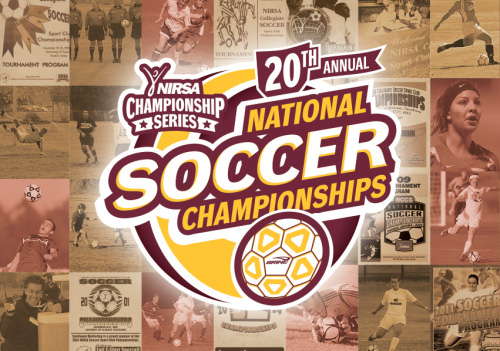 NIRSA Soccer celebrated its 20th anniversary in 2013.
NIRSA Soccer celebrated its 20th anniversary in 2013.This 2013 tournament was set to be one of our best yet. Not only was it to be to be a celebration of soccer, the players, the schools, and the staff that make this event possible, but also a celebration of the history of the tournament, with past directors and regional coordinators in attendance for our landmark 20th event.
And the first day of tournament play didn’t disappoint. Tournament staff member and blogger, Mario Rios, relates that “the tournament had set up great possible match ups. Michigan State, 2012 national champions and Weber State, 2012 runner-up, each won their pools with eyes set to repeat their march to the final in this year’s men’s championship division. UCSB, the only returning finalist in the women’s championship division from 2012 and previous five-time national champion, looked poised to return to the final again by winning their pool. San Diego State, defending men’s open champion, were also undefeated following day one, while James Madison, defending women’s open champion, faced a setback with one win and one loss.”
The forecasted rain remained light throughout Thursday afternoon, but things changed that night, just as games were ending. The rain continued to fall and Reach 11 staff closed the fields Friday, while tournament staff worked on a shortened schedule for Saturday. Teams did what they could on Friday to keep their spirits up and enjoy the time with their teammates—whether it be playing games in the hotel lobbies, hanging out at the pool, touring the city, or spending the afternoon seeing the Hunger Games.
But, despite everyone’s hopes and intentions, by Saturday morning the rain still had not let up. The city of Phoenix, which averages 0.65 inches of rainfall during November, had quadrupled that—within just 30 hours. The record-setting rain, which left soft-spots and puddles on the fields of play, as well as stream-like puddles along the sidelines, forced Tournament Director, Valerie McCutchan along with Co-Directors of Competition Randall Ford and Doug Ewing, along with the Reach 11 Sport Complex staff, to cancel the remainder of the tournament.
The decision was devastating for all involved—all who had traveled long distances, sacrificed time, money, and effort all year long, and those whose hopes were pinned on a chance at the national title and celebrating our 20th anniversary—a momentous and hard-fought milestone. Understandably, though, it was the players everyone felt for the most.
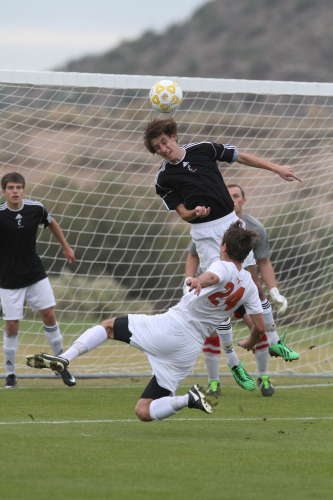 The first day of play for the 2013 tournament brought strong competition.
The first day of play for the 2013 tournament brought strong competition.“As a player it is so difficult to understand why,” says Mallory Price, Coordinator of Intramural and Club Sports at University of Colorado-Colorado Springs. “Why is the tournament being cancelled, why can’t we play, why can’t we find a different field?” Mallory knows these questions first hand, having been not only a staff member at this year’s tournament, but also a player on the Michigan State Women’s Club Soccer team in 2004, during the only other tournament cancellation. “I found it very difficult to swallow the decision of the staff to cancel the 2004 Austin tournament. The feeling of helplessness as a player and all those unanswered questions were tough to handle.”
Jeremy Engel, Assistant Director of Campus Recreation-Sport Programs at UNC-Asheville, shares Mallory’s unique perspective. As a senior with James Madison University, having the 2004 tournament rained out was a huge blow. “As a player,” he says, “all I wanted to do was play. I wasn’t concerned with player safety, the other teams, or ‘the big picture’.”
So, during this 2013 tournament, he empathized with the athletes and their feelings. “As a player you’re trained to focus on the task at hand—the first game, your roll, etc. When all the hard work you put in doesn’t have the opportunity to come to fruition, you feel somewhat robbed… [and, understandably,] you are just thinking about the effect it has on you and your team. You’re thinking that ‘it’s just rain and I’ve played in rain before’. You aren’t thinking about the financial commitment to rebuild the fields or the safety component if someone were to be seriously injured.”
As staff members, both Jeremy and Mallory agree that the considerations are much different—and much clearer. “It’s the worst feeling in the world as an administrator to have to tell teams that they will not be able to play due to conditions out of my control,” Mallory says. However, “after many years working in intramural and club sports I now understand…that every climate, state, and facility handles weather differently. In Phoenix this year, the facility and fields simply could not handle the amount of rain we received.”
Likewise, Jeremy’s years of professional experience have given him a similar perspective. “I completely understood the issues at hand [in Phoenix]. Although some games probably could have been played, it would have caused much larger issues for the city of Phoenix and their future events at the Reach 11 Complex.” Not to mention that what starts out as a soft field for one game can quickly deteriorate into a mud pit by the fifth, tenth, or fourteenth game, drastically increasing the risks of injury for players. “As an administrator,” Jeremy continues, “from the very beginning you know it’s all about player safety and the big picture. You realize that there are 96 teams, a city’s sports commission, and a very high profile complex all affected by the tournament. It’s not one thing but a number of things to consider.”
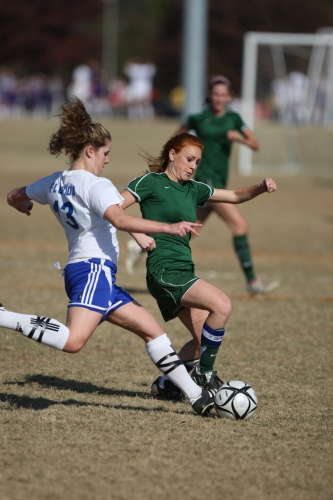 We look forward to more great soccer action at next year’s tournament in Memphis.
We look forward to more great soccer action at next year’s tournament in Memphis.As we move forward, Jeremey reminds the players that “we (NIRSA) are very fortunate to be given the opportunity to play at such a beautiful complex, and I hope [the athletes] enjoyed the two games they were able to play…and were able to create a memorable experience out of the weekend, returning to campus with new friends and stories.”
Mallory echoes this, saying, “as I look back on my experience in club soccer, yes, I remember some of the wins, and, unfortunately, losses, but my fondest, most clear memories are those that I made with teammates off the field—the fun car ride mixed CDs, the crazy dance parties in hotel rooms, team dinners, and, most importantly, meeting the people I still call my friends to this day.”
Indeed, there is a bigger picture, bigger, sometimes, even than soccer. As tournament staff turn to planning the 21st NIRSA Soccer Championships in Memphis, TN, they hope for many moments that celebrate soccer, the sport that brings hundreds of volunteers together every year—moments like one of Howard’s favorites, in the tournament’s third year, during a late night playoff game between James Madison and Purdue University’s women’s teams. “It was an exciting game,” he says, “down to the wire, and it went to penalty kicks. Each team had a men’s team at the tournament and so the stands were just packed. It was loud—hundreds of people were singing and chanting. And at the end—I don’t even remember who won—the men’s teams ran out on the field and built an archway with their hands and all the women’s players ran under it together. It was a celebration of soccer.” But, as much as they treasure these moments, staff—so many of whom have been a part of this competition since its inception—know there’s also more at stake.
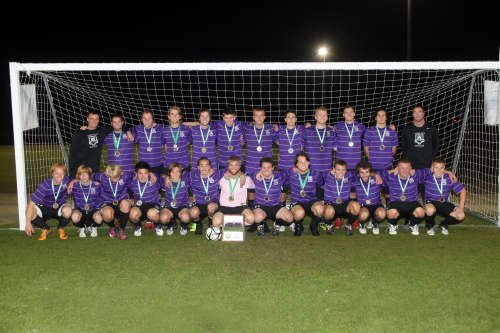 Weber State University team, 2011.
Weber State University team, 2011.A key example Doug points to is from 2011 in the form of an email from Will Rader, coach at Weber State University. Weber State won the championship that year, but the victory was a mere side note. The email told the story of the team’s goalkeeper, whose brother and sister were in comas after a tragic car accident. After playing “the game of his life,” the keeper described it to his brother over speaker phone and the boy opened his eyes and smiled for the first time. The brother passed away the next day, but, as Will writes, “The only thing really keeping him from breaking down completely is the fact that he had the game of his life on the biggest setting available to our student club athletes and dedicated it to his brother!” Will goes on to say, “I have grown to learn that soccer is not the only thing in life, but the memories that we experience along the way and at the National Championship tournament are some of the key life experiences that help direct our lives.”
“I got teary eyed when I read that,” Doug recalls. “This is why we do what we do.” Continuing that mindset—and staying true to the values and soccer-passion the tournament was founded on will help “maintain this quality experience for participants, which is really critical,” Randall says, “because it goes way beyond competition and wins and losses. It’s about the players and the building of memories.” And so we will continue to build—in Memphis, and beyond.


